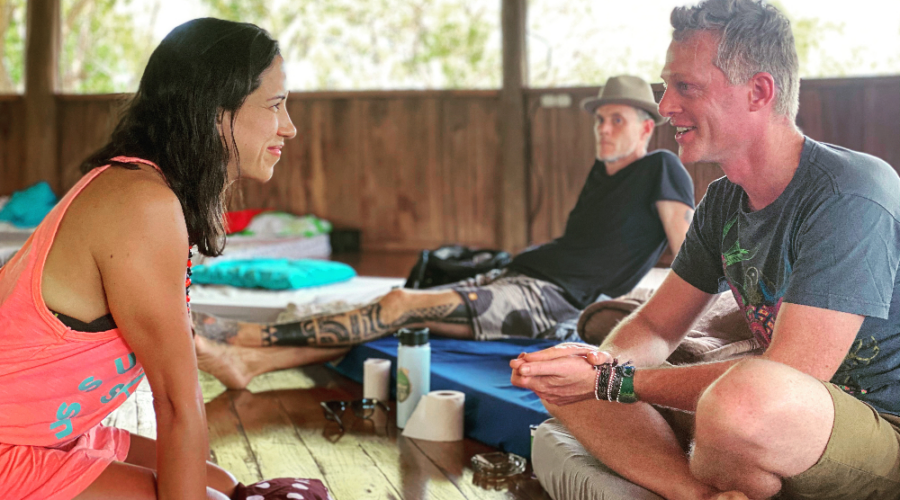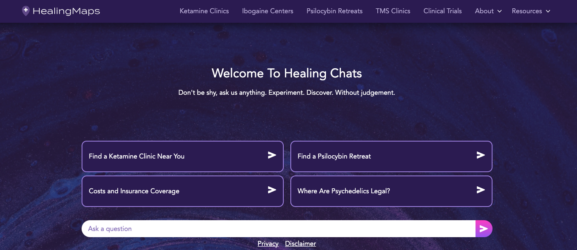What Should You Wear to a Psychedelic Experience? How Clothes and Shoes Impact Your Trip
Should your toes be free? Should you wear synthetics? Here’s what you need to know.
“Your body wants to breathe.”
That’s what I kept telling myself as I lay on the floor of a straw-thatched hut in the middle of the Colombian rainforest. It had been nearly an hour since I drank my first cup of ayahuasca—the South American brew rich in the psychedelic DMT. Focusing on my breath seemed to slow everything down to a harmonious whir.
I tried to visualize every breath I sipped in, sending that rich jungle oxygen to the deepest parts of me—the internal organs I have never seen as well as places much more familiar: the top of my head, the corners of my closed eyes, my clenched jaw, my fingertips, my littlest toes.
Like my fellow journeyers, my clothes for the evening were minimal. I wore a long, flowing skirt and a loose tank, that, I kept telling myself, seemed to help my body breathe as if every cell had its own pair of lungs.
My sandals were neatly stowed a few feet behind me just outside of the open-air hut, which is to say they were a world away—in that “other,” everyday world where we’re always wearing shoes, and often struggling to breathe freely.
In a sacred medicine ceremony, save for flip flops, most any other footwear seems woefully misplaced. To have feet bound in tight-fitting shoes was anathema to the connection the medicine offers. After all, what connects us to the earth, to reality, more than our feet? If psychedelics are an altered state of consciousness, shouldn’t we have an altered state of footwear?
Interested in joining a Psychedelics Clinical Trial? Sign up here now and we will connect you with a clinical trial in your area when one becomes available.
Does Closing Ourselves Off From the Earth Help or Hurt Us?
It’s not just in these medicine circles where shoes (and rigid clothes) are out of place. Cultures around the world leave shoes at the door. Leaving shoes outside keeps harmful bacteria out, but also brings benefits to the shoeless; research shows that more often than not, shoes cause physical damage to our delicate, clumsy feet—from in-grown toenails and bunions to fasciitis, neuromas, and more. These are conditions unshod communities typically do not experience.
READ NEXT: How Treatment Centers and Retreats Set the Setting
Not only does shoelessness improve balance and agility, but there’s research that has shown going barefoot, especially in nature (a practice sometimes called earthing or grounding), can improve our health in a variety of ways, from better sleep and reducing pain, to improving balance and reducing stress.
This is never more true than when using psychedelics. Setting dictates much of the outcome of the psychedelic experience. These days, a growing number of people are experiencing psychedelics in a very urban environment—perhaps a ketamine clinic in a major metro area or a therapist’s office. There are advantages here, certainly (including fewer mosquitoes). But the formality of these locations and the need for more formal attire than what one might wear in the remote jungle can have an impact on the overall experience.
What Should You Wear to a Psychedelic Experience
Chianti Huang, Ph.D., founder of the integration and coaching company The Psychedelic Way, says some general clothing rules do make a difference. “I highly recommend a breathable, comfortable dress code for the experience,” she says. “Try to wear natural and organic material such as cotton, linen, or silk.”
The littlest things can become big distractions during a psychedelic journey, so being comfortable is a critical consideration. The body may experience bouts of increased blood pressure, accelerated heart rate, and overall increased sensitivity, which can make restrictive clothing and shoes even more bothersome. Then, there are the emotional, psychological, and spiritual effects. Intense emotions such as fear and sadness can occur when working through a past trauma, and that can also become intensified in restrictive clothing.
Have Psychedelics Loosened Our Wardrobes?
Psychedelics may have influenced dress codes among psychonauts in the last half-century. Consider the pictures from the first time Westerners documented a psychedelic mushroom ceremony, when an employee of J.P. Morgan in New York met a Mazatec mushroom curandera. In the pictures in Life Magazine in 1957, R. Gordon Wasson wears a snug shirt, vest, coat and slacks; Maria Sabina, on the other hand, wears a relaxed dress and a light shawl. Yet the sartorial differences between the two cultures may have narrowed, in part thanks to psychedelics. Westerners who followed Wasson’s lead into the psychedelic realm often dropped their Wasson-esque ties. After Harvard professors Tim Leary and Richard Alpert (Ram Dass) embraced mushrooms and LSD in the early 1960s, they swapped out tweed jackets and pencil-thin ties for white robes and open collars. Thousands of young people tried LSD and followed their lead to Woodstock, Silicon Valley, and beyond.
READ NEXT: Psychedelic Therapist Training: How to Become a Certified Psychedelic Therapist
What Should You Wear to a Psychedelic Experience: Shoes (But Not Clothing) Optional
Huang says a psychedelic journey is best experienced shoeless. Even being barefoot in an office or ketamine clinic can make the psychedelic experience feel less restrictive, Huang says.
For some, the experience may make foregoing all or most clothing feel necessary. (But it’s also important to keep in mind, especially if you’re traveling internationally, that some cultures may prefer or even require modest coverage.)
In that warm Colombian jungle (and the inner jungle brought about by the ayahuasca), I understood that the line that separates us from the natural world is very much an illusion. I wasn’t a person out there in the middle of nature; I was—am—nature itself. And that, of course, means so too are shoes. But the more distance we put between ourselves and the natural world, the more difficult it is to make that connection. Just like it can be hard to breathe in polluted, urban environments, restrictions during a psychedelic experience can make it hard to go where the medicine needs to be. Your body wants to breathe.
RELATED: What To Bring to a Psychedelic Treatment—and What to Leave at Home
READ NEXT: Ayahuasca Helped Find Lost Amazonian Children. Can Psychedelics Really Give You Superpowers?



